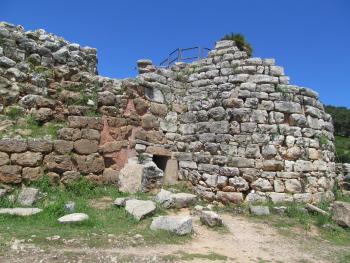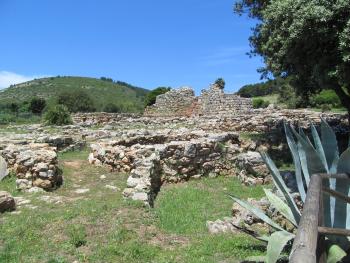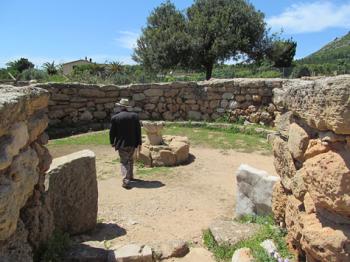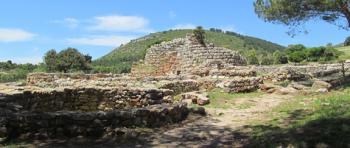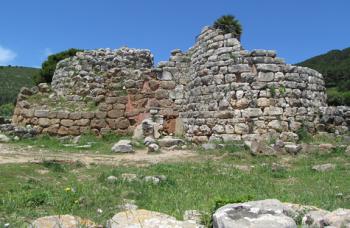The nuraghi of Sardinia
This item appears on page 45 of the May 2019 issue.
Three thousand years ago, stone towers — often surrounded by settlements enclosed within stone walls — peppered the Sardinian countryside. There were an estimated six to seven thousand of these towers constructed in the period roughly between 1600 and 550 BC, the Bronze and Iron ages in Sardinia. Perhaps many more still lie undiscovered beneath the ground or covered by earth mounds.
These stone towers are called nuraghi (singular, nuraghe), and they have become identified with Sardinia, itself. They are unique to this island, part of Italy, which lies in the Mediterranean west of the Italian mainland. Indeed, Rome is only little more than an hour’s flight from Cagliari, Sardinia’s capital.
Travelers might notice similarities between the Sardinian nuraghi and archaeological structures in other parts of Europe — on the neighboring island of Corsica, in the Balearic Islands, in Greece, even in Scotland — but nothing exactly like what developed in Sardinia.
Nuraghic Age
Nuraghic civilization developed beginning perhaps as early as 1800 to 1700 BC but certainly by about 1600 BC.
People settled into small communities to raise crops and cattle and needed to protect their settlements. The earliest nuraghi they built were simple conical towers constructed of stone. These towers, which were entered at ground level, were built with internal wall niches for storage and with embrasures to admit light as well as with a staircase leading to one or more upper levels.
With the passage of time, the single towers often were reinforced with additional towers joined by a stone curtain wall to form a bastion. Sometimes a low stone wall was built to enclose the complex of towers. Village huts clustered outside the nuraghic complex.
On our trip to Sardinia, my husband, Paul, and I visited four nuraghic complexes, including the famous Su Nuraxi Nuraghe, at Barumini, a UNESCO World Heritage Site.
Nuraghe Palmavera
Spectacular as Su Nuraxi is, my favorite Sardinia nuraghe is Palmavera, 6 miles northwest of the city of Alghero in northwestern Sardinia. I prefer this nuraghe above the others because it’s so close to the lovely city of Alghero, it’s relatively uncrowded and it’s easy to tour on your own, unlike Su Nuraxi, where visitors are obligated to join a tour group.
The central nuraghe at Palmavera was probably built around 1400 BC, well after the Nuraghic Age had begun in Sardinia. It exhibits all the features of a typical nuraghe: corridors, niches and vaulted ceilings as well as a staircase to reach upper floors and the roof.
A second tower was added later, probably after 900 BC. A stone curtain wall connected the two towers, creating an elliptical bastion. Soon after this was constructed, perhaps within 50 to 100 years, three stone huts and a large meeting hall were built around the bastion, joined to each other by a low stone wall.
Meeting hall
The Palmavera meeting hall, similar to others found at other nuraghic sites, is especially interesting because of its large size — 39 feet in diameter — but also because it is ringed on the inside with stone seating to accommodate at least 40 individuals. Also interesting are the simple sandstone throne stool and a stone model of a nuraghe on a pedestal that were found inside.
It is thought that the meeting hall was used for religious and ritual purposes as well as for administrative and political matters. The miniature nuraghe found there might have “housed” their god.
Dozens of house huts with stone bases lie scattered around the archaeological site, spread out haphazardly outside the low stone wall that separated the nuraghi from the huts. The hut walls and roofs, probably built of tree branches, have long since disappeared.
All came to a sudden end for Palmavera toward the end of the 8th century BC, when a devastating fire consumed the nuraghic complex, leaving us just the stone remnants we see today.
More nuraghic sites
The three other nuraghic sites that Paul and I explored were Su Nuraxi, at Barumini, Sardinia’s most-visited nuraghic site and one of its largest; Losa, at Abbasanta, with an impressive bastion enclosing the central tower, and Lu Brandali, where a tomba di giganti, or giants’ tomb, a large communal grave, lies a 5-minute walk from the nuraghic complex.
Sacred well
Four miles from Losa Nuraghe lies another of my favorite Sardinian archaeological sites, the sacred well of Santa Cristina, at Paulilatino.
Preceded by an atrium enclosed within low stone walls, this 11th-century-BC well has a monumental staircase leading down to the water. Priest and pilgrims must once have congregated there for religious ceremonies.
There is a single-tower nuraghe nearby and traces of the village that had surrounded the tower.
Tharros and Nora
Two other mostly non-Nuraghic Age archaeological sites we visited were Tharros and Nora. Both sites have very long histories, extending from the Nuraghic Age to subsequent occupation by Phoenicians (8th century BC), Carthaginians (6th century BC) and Romans (from the 3rd century BC on), finally being abandoned in the Middle Ages because of Saracen raids and/or malaria.
At Tharros, a long, basalt-paved street leads uphill past remnants of Roman shops and houses to a Phoenician tophet, where children were buried (legend says they were sacrificed to the Canaanite god Moloch).
At Nora, there are Roman houses with intricate intact mosaics and a lovely, small Roman theater built beside the sea.
Sardinian cities
We based ourselves in three places during our nine days in Sardinia: Alghero, Oristano and Cagliari.
Cagliari’s citadel, Il Castello, atop a hill, is filled to overflowing with a Pisan Romanesque cathedral, a first-rate archaeological museum and old palaces and towers lining narrow medieval streets.
Oristano has a lovely central square, Piazza Eleonora d’Arborea, and a splendid Baroque cathedral with a 14th-century bell tower.
But the city I loved most was Alghero, with a medieval quarter tucked within high-walled battlements and crammed with shops and cafés.
If you go…
Nuraghe Palmavera (www.nuraghepalmavera.com [in Italian only]) is open daily from 9 to 7, May to September, from 10 to 2, November to March, and from 9 to 6 in April and October. There is an entry fee of €5 (about $6).
Unlike some of the archaeological sites in Corsica that I found difficult to visit, I had few problems with sites in Sardinia, with the one exception of the interior of Su Nuraxi Nuraghe, which was a maze of dark, narrow tunnels and uneven steps. Every other archaeological site I visited was doable.
Paul and I visited Sardinia and Corsica in May 2018 on a 19-day private tour with a car and driver that was arranged by Olde Ipswich Tours (978/356-5163, www.ipswichtours.com), in Massachusetts. For more info about our tour, see my article on Corsica (Feb. ’19, pg. 49).

